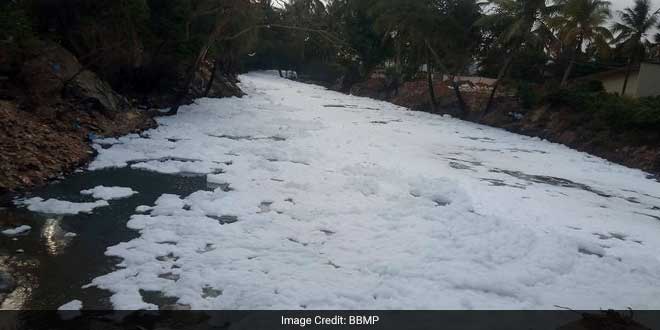Highlights
- Froth reappeared in Bellandur lake after night of rainfall on June 14
- The NGT report heavily criticised Bengaluru’s civic agencies’ role
- No progress on revamping pipelines to divert sewage dumped in the lake: NGT
New Delhi: Bellandur lake spews out toxic froth again. Bengaluru residents woke up to thick froth emerging from the lake once again on Wednesday, June 14. The incident coincided with the National Green Tribunal’s report on the lake, which blamed the state government and the civic agencies for failing to curb pollution in the lake, terming it as ‘Bengaluru’s largest septic tank.’ The NGT report said that continuous encroachments and dumping of domestic and industrial waste into the lake has turned it into a polluted mess, which resulted in frequent fires and toxic froth generation.
Froth was seen flowing in heavy quantities from the lake on Wednesday morning. The Bruhat Bengaluru Mahanagara Palike (BBMP) operated sprinklers, which keep toxix froth from being formed around the lake, work from morning to evening, but is shut down during night to conserve water. The froth from the lake continued to flow into the streets, a scene residents of Bengaluru have become accustomed to, as there have been 12 fire breakout and frothing incidents at the lake since 2016. The regularity with which toxic froth has formed at the Bellandur lake has put the BBMP into a fix, which has claimed to be cleaning the lake since 2016, but incidents of frothing and fires have continued despite the civic body’s efforts.
“Frothing has become regular near Bellandur. The toxic froth flies on to the road when there is heavy wind or rain. The froth is extremely toxic in nature and inhaling the foam has been known to cause severe headache and nausea. The BBMP and Bengaluru Development Authority have not been able to contain the froth, despite this happening for years,” said Meera Gopinath, one of the members of Kasa Muktha Bellandur, a volunteer group engaged in solid waste management in Bellandur.
In September 2017, civic agencies of Bengaluru such as BBMP and BDA told the NGT that the Bellandur lake could only be wholly cleaned by 2020. The cleaning of the lake could take place after flow of untreated sewage into the lake stopped, the BBMP had said. The NGT report, which was compiled after the tribunal inspected the lake for over six months, said that there was not even 1 ml of unpolluted water in the lake. The report said that Bellandur lake’s water holding capacity has come down from 13 million cubic metre to 5.5 million cubic metre, due to unprecedented dumping of waste and sewage. Weeds present in the lake has made its water unfit for use. NGT said that there was no progress in revamping pipelines in residential or commercial areas to divert sewage into treatment plants.
“The inspection conducted by NGT found that work on revamping pipelines has not made much progress and the flow of sewage continues into the lake. The lake has seen 12 fire breakouts since 2016. If such scale of pollution continues, it will not be long before the lake itself dies,” said Dr R Nagendran, Member, National Green Tribunal, Southern Zone Bench.
While the BBMP refused to comment on the NGT report, the Bengaluru Development Authority said that about 180 million litres of sewage enters the lake daily, and it was difficult to stop the flow on a short notice, as pipeline revamping and restructuring works would cost around Rs 500 crore. The total budget of the BDA and the BBMP together cannot cover such huge costs and hence are waiting for financial assistance from the state.
Basavaraju, member Secretary of the Bengaluru Development Authority said that de-weeding of the lake is going on in full swing and the BDA will present a compliance report before the NGT soon. Bellandur lake however, remains caught in the crossfire between several government and civic agencies. The BBMP is in charge of looking after sewage flow into the lake, while the BDA is responsible for the overall maintenance of the lake. Additionally, the Karnataka Lake Conservation and Development Authority (KLCDA) was also in-charge of monitoring the lake for cleanliness till February 2018, before it handed over the reins to the state’s irrigation department. The presence of so many authorities has done Bellandur lake more harm than good, and with froth and fires continuing to be frequent, the lake stares at gradual death.






























